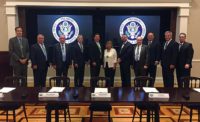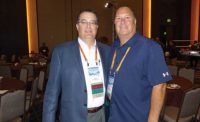American Supply Association members made the most out of their recent visit to Washington, D.C. During the final day of NETWORK2019, which celebrated ASA’s 50th anniversary, volunteer association leaders and staff members went to the White House to sign the Pledge to America’s Workers initiative.
At the tail-end of the meeting, ASA President Steve Cook of Northeastern Supply signed the pledge, which commits to expand programs that educate, train and reskill American workers from high-school age to near-retirement. It stems from part of the National Council for the American Worker where the Trump administration is asking companies and trade groups throughout the country to sign the pledge.
Since President Trump signed the executive order, more than 300 companies and organizations have signed the pledge, contributing to more than 14 million new education and training opportunities for American students and workers over the next five years.
Members of ASA’s contingent met with Rosemary Lahasky, special assistant to the President and director of domestic initiatives at the White House.
“With the economy sort of roaring, employers are desperate for every employee they can get, which has created an amazing opportunity,” Lahasky told the ASA group. “We have the ability now to reach individuals, get them up-skilled and get them into the workforce because people are so hungry to fill jobs.”
Lahasky said the initiative’s advisory board is focusing on a number of main areas, including developing a campaign around multiple pathways to career success, trying to better match available jobs and the skills needed, and measuring the effect of employers providing education and training to their workforces.
ASA CEO Mike Adelizzi talked during the meeting about the importance of getting apprenticeships and craft training back into the high schools. Lahasky noted the Trump administration is a big champion of the reauthorization of the Perkins Career Technical Education Act. “This is a really big source of federal funding around high school vocational education,” she said. “Our hope is that we will see more career technical education happening in high school.”
ASA Acting COO/ Vice President Advocacy, Jim Kendzel noted one major point of contention is the branding of the PHCP-PVF industry as an attractive career opportunity. “I heard one of our members the other day say, ‘We create a flow,’” he said. “America flows because of us, whether it’s industrial processing or plumbing. How do we get these young people interested in the trades, the construction business and wholesale-distribution?”
Lahasky, in response, said the biggest thing that can be done at the federal level is “talk about the end result,” she said. “We know these jobs pay well. It’s a matter of getting the information out to the students and their parents. Graduation rates from college are about 60%. Two-year colleges, the rate is even worse. You are going to go to school and you may not graduate. Forty percent of people who have jobs today have a job that they didn’t need a degree for. They have racked up enormous student debt and they are not making nearly what could be made had they gone into an industry such as yours (PHCP-PVF). How about we start to make the data transparent so people can see the real end results of what the outcomes are. You can make a lot of money doing a lot of different things, doing something you are really passionate about. From our end, we want to talk about the outcomes and what the end result is and how you can have good family-sustaining jobs in this country.”






